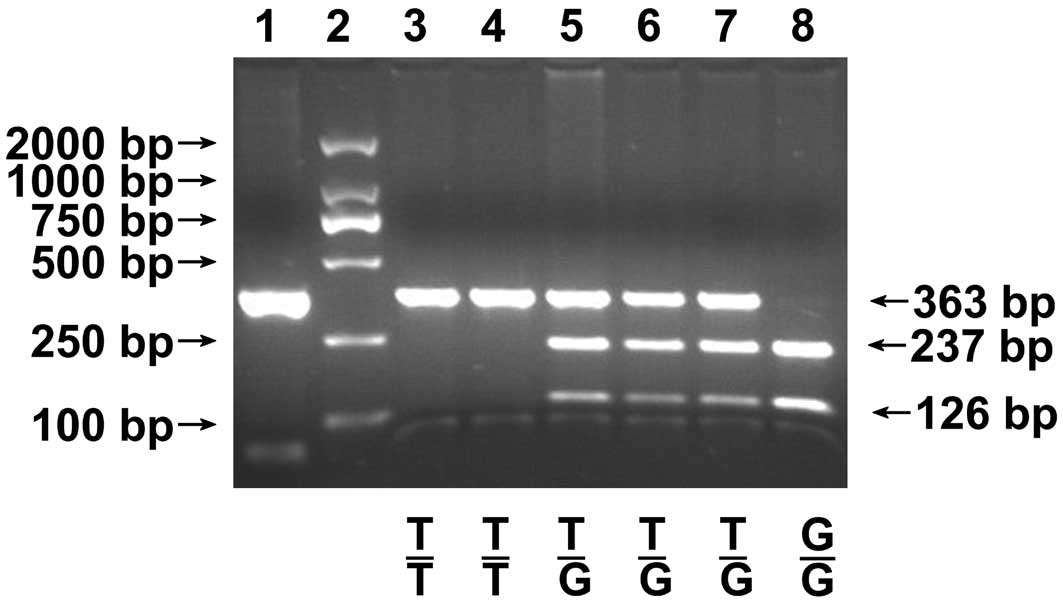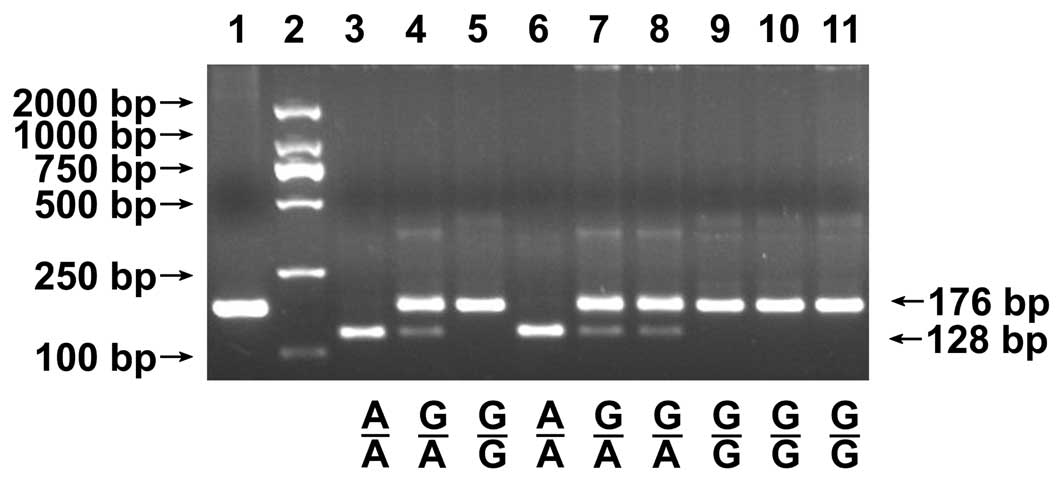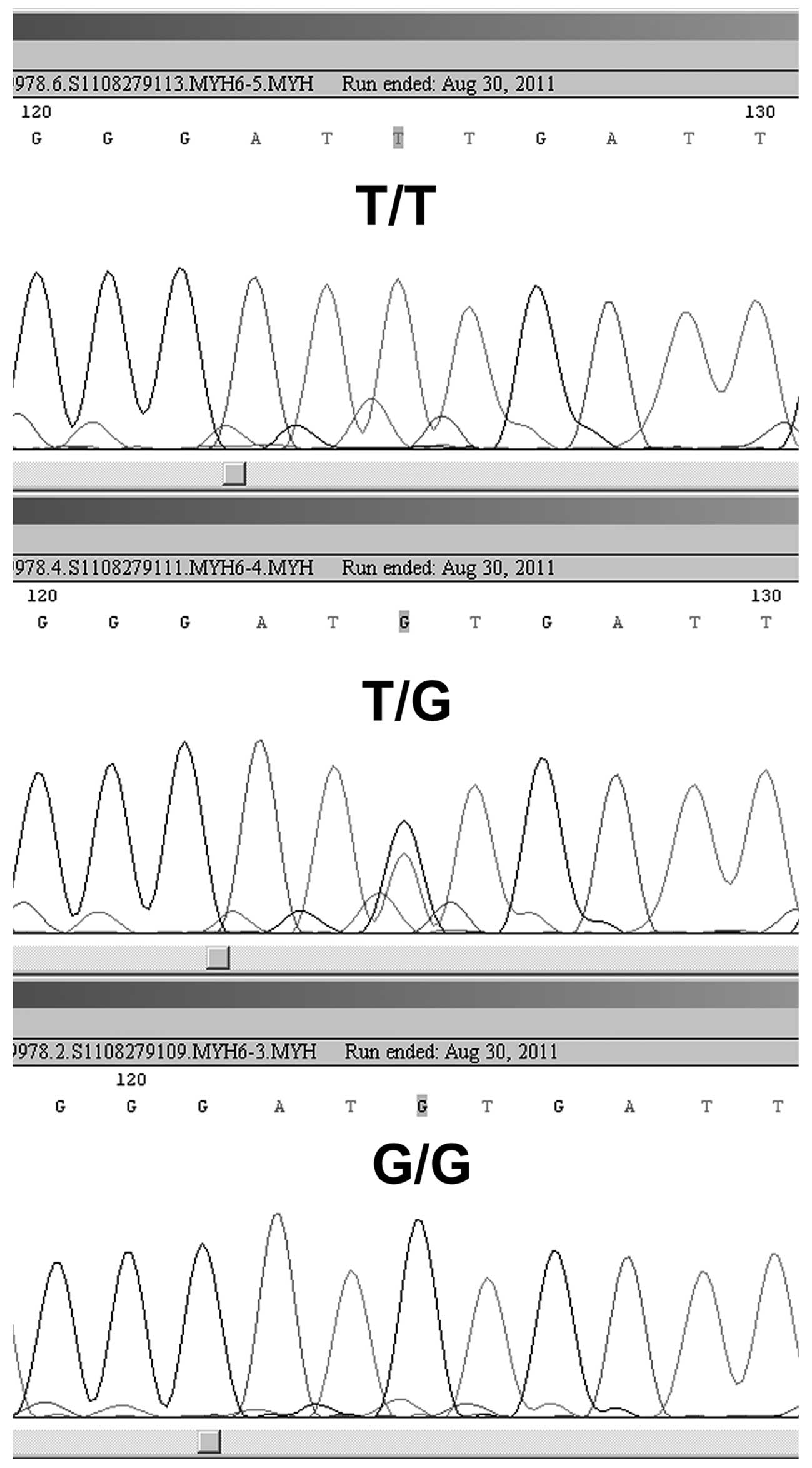MYH rs3219476 and rs3219472 polymorphisms and risk of cholangiocarcinoma
- Authors:
- Published online on: November 8, 2012 https://doi.org/10.3892/mmr.2012.1175
- Pages: 347-351
Abstract
Introduction
Cholangiocarcinoma (CCA), originating from the epithelial cells lining the biliary duct, is a rare but devastating malignancy (1,2). CCAs are clinically silent in the majority of cases (3). Radical resection of the tumor is applicable only in a minority of patients due to late clinical presentation and diagnosis (4). Moreover, the recurrence rate following resection is extremely high (5). Although advanced CCAs may respond to chemotherapy, there are no standard treatments for the palliation of advanced disease (3). The overall survival rate of the disease is poor (6).
Although a number of risk factors have been identified, including primary sclerosing cholangitis (PSC), infestation with liver flukes, toxic compounds, congenital disorders, hepatolithiasis, viral hepatitis, alcohol abuse, smoking, obesity and diabetes (4,7), only a minority of CCA patients have known risk factors. Up to 90% of patients presenting with CCA have no identifiable risk factors (4,6).
CCA, in common with certain other cancers, is caused by gene-environment interactions. Carcinogens induce tumorigenesis in genetically susceptible individuals (8,9). Genomic DNA is continuously attacked by a large number of agents that damage DNA. However, cancers only occur in a small proportion of people since DNA damage is normally repaired by genome surveillance mechanisms and DNA repair pathways, including homologous recombination (HR), base excision repair (BER), nucleotide excision repair (NER) and mismatch repair (MMR) (10). Polymorphisms of DNA repair genes may affect the quantity and activity of the resulting protein and the DNA repair capacity. The possession of specific alleles of polymorphic genes may increase susceptibility to cancers and facilitate cancer development in normal or exposed individuals (11).
The BER pathway has a principal role in the repair of mutations caused by oxidized or reduced bases. Human oxoguanine glycosylase 1 (hOGG1), MutY homolog (MUTYH, MYH), apurinic/apyrimidinic endonuclease-1 (APEX1, APE1) and X-ray cross-complementing group 1 (XRCC1) are key proteins in the BER pathway (12–14). We have previously analyzed hOGG1 Ser326Cys and XRCC1 codon 194 and 399 polymorphisms in CCAs and did not find an association between polymorphisms of these genes and susceptibility to CCA (15,16).
MYH is involved in the repair of mutations caused by oxidized bases (13,14). Harmful environmental agents may cause the production of reactive oxygen species (ROS), including hydroxyl radicals, in the body (14). Oxidative DNA damage occurs when the production of ROS exceeds the antioxidant capacity of the cell (17). 8-Hydroxy-2′-deoxyguanosine (8-oxoG) is one of the most abundant and stable products of oxidative DNA damage and may cause G:C to T:A transversions (14,17). The BER pathway is responsible for repairing 8-oxoG lesions. MYH is a DNA glycosylase that removes adenine paired with 8-oxoG (13). Biallelic loss of MYH is associated with somatic G:C to T:A transversions in the adenomatous polyposis coli (APC) gene and is responsible for polyp formation and colorectal cancer (18). However, the role of MYH in the tumorigenesis of CCA is largely unknown. It has been reported that one SNP in the MYH gene (rs3219476) was associated with an increased risk of treatment-related mortality (TRM) in recipients who took alkylating agents with or without ionizing radiation for pretransplant conditioning regimens and underwent allogeneic hematopoietic cell transplant (HCT) for the treatment of hematologic malignancies (19). However, the relationship between MYH rs3219476 polymorphism and the risk of CCA has not been reported. In this study, we evaluated the influence of polymorphisms of two adjacent SNPs (rs3219476 and rs3219472) in the MYH gene on the risk of CCA in a Chinese population.
Materials and methods
Subjects
A hospital-based case-control study of CCA was conducted in the Second Affiliated Hospital of Nanjing Medical University between May 2007 and June 2010. Written informed consent was obtained from all participants and the study was approved by the Ethics Committee of the Hospital. The cases were 59 CCA patients aged from 27 to 86 years with an average of 64.7±15.5 years. Among the patients, 37 cases were male and 22 were female. The patients were diagnosed with CCA according to clinical presentations and imaging, including computerized tomography (CT), magnetic resonance imaging (MRI), magnetic resonance cholangiopancreatography (MRCP) and endoscopic retrograde cholangiopancreatography (ERCP) (20). Ten cases of CCA diagnosis were confirmed by histology. None of the cases had a history of any cancer other than CCA. A total of 100 controls with no current or previous diagnosis of cancer or other major diseases were recruited. Among the controls, 59 were male, 41 were female, and the average age was 61.7±10.2 years. All subjects were unrelated Han Chinese living in Jiangsu province.
Blood samples and DNA isolation
Venous blood (3 ml) was collected from each of the CCA patients or controls. After collection, the whole blood was immediately stored at −80°C until use. Genomic DNA was extracted from the blood samples by a routine phenol-chloroform method.
Genotyping of MYH rs3219476 and rs3219472 polymorphisms
MYH genotypes were detected using a polymerase chain reaction-restriction fragment length polymorphism (PCR-RFLP) technique. MYH rs3219476 and rs3219472 were amplified to form undigested fragments of 363 and 176 bp, respectively, using primers designed by ourselves with a web-based PCR-RFLP designing tool, SNP PCR-RFLP assay design at http://bioapp.psych.uic.edu/SNP_cutter.htm. The primers used were as follows: forward 5′-GGA AGG AAG TGA CGT GAT CTG G-3′ and reverse 5′-TGG TGG TCT CTT CAC ATG GAC A-3′ for rs3219476; forward 5′-GTA AGA GCT ACA AGG CAG-3′ and reverse 5′-GCT TAA ACA CCT CAA GTG-3′ for rs3219472. Briefly, 50 ng genomic DNA was amplified in a volume of 50 μl containing 1X PCR buffer, 1.5 mM MgCl2, 0.2 mM of each dNTP, 0.5 μM of each primer and 1.25 units Taq DNA Polymerase (Takara Biotechnology, Dalian, China). The PCR conditions were a 5 min denaturation step at 94°C; followed by 40 cycles of 94°C for 30 sec, 60°C for 30 sec and 72°C for 30 sec; and a final extension at 72°C for 10 min. After amplification, 8 μl PCR products were digested with BtsCI at 50°C or Tsp509I at 65°C for the genotyping of rs3219476 or rs3219472, respectively, for 4 h in a final volume of 20 μl containing 1X NE buffer and 0.5 μl (2.5 units) restriction enzyme (New England Biolabs, Beverly, MA, USA). The digested fragments were separated by electrophoresis on 2% (w/v) agarose gel and visualized by ethidium bromide staining using a DL2000 DNA Marker (Takara BioTechnology). All experiments included positive and negative controls. For rs3219476, the wild-type genotype T/T had no BtsCI site and was characterized by a 363 bp fragment on the gel; the variant genotype G/G was characterized by 237 and 126 bp fragments; and the heterozygous genotype T/G was characterized by 363, 237 and 126 bp fragments (Fig. 1). In the genotyping of rs3219472, the complete digestion of PCR products produced 176 bp fragments for the G allele and 128 bp and 48 bp fragments for the A allele (the 48 bp fragment was too small to resolve accurately; Fig. 2). DNA sequencing was performed to confirm the genotypes in certain cases (Figs. 3 and 4).
Statistical analysis
Mean and standard deviations are presented in cases of continuous variables. Differences between the means of the two continuous variables were evaluated by the Student’s t test. The Hardy-Weinberg equilibrium was tested using a web-based program, OEGE (Online Encyclopedia for Genetic Epidemiology) at http://www.oege.org/software/hwe-mr-calc.shtml, to compare the observed genotype frequencies with the expected frequencies among the control subjects. The Chi-square test was used to compare the gender distribution and test the association between the genotypes and alleles in relation to the cases and controls. P<0.05 was considered to indicate a statistically significant result. The odds ratio (OR) and 95% confidence interval (95% CI) were calculated to estimate the associations between the genotypes of MYH and the risk of CCA. Statistical analyses were carried out using SPSS version 11.0 software (SPSS, Chicago, IL, USA) and Microsoft Excel 2003 (Microsoft Corporation, Seattle, USA).
Results
The case and control groups were not statistically different with respect to age (t=1.335, P=0.185) and gender (χ2=0.214, P=0.644). The frequencies of the MYH rs3219472 genotypes associated with CCA are shown in Table I. For rs3219472, the genotype frequencies of G/G, G/A and A/A were 47.5, 32.2 and 20.3%, respectively, in the CCA cases compared with 46.0, 47.0 and 7.0%, respectively, in the controls. The genotype distribution in the controls was within the Hardy-Weinberg equilibrium (χ2=1.18, P>0.05). The frequency of the MYH rs3219472 A allele was 36.4% in the CCA group and 30.5% in the control group. Statistically significant differences were observed in the genotype frequencies of the MYH rs3219472 polymorphism between the control group and the patients with CCA (χ2=7.499, P=0.024), but no statistically significant differences were identified in the allele frequencies of the MYH rs3219472 polymorphism between the two groups (χ2=1.190, P=0.275). Compared with subjects carrying the MYH G/G genotype, those with the A/A genotype had a 2.816-fold higher risk of CCA (OR=2.816, 95% CI=0.992–7.999, P=0.047).
Table IDistribution of allele and genotype frequencies of MutY homolog (MYH) rs3219472 polymorphism in cholangiocarcinoma (CCA) patients and healthy controls. |
As shown in Table II, for rs3219476, the genotype frequencies of T/T, T/G and G/G were 42.4, 33.9 and 23.7%, respectively, in the CCA cases compared with 26.0, 58.0 and 16.0%, respectively, in the controls. The genotype distribution in the controls was within the Hardy-Weinberg equilibrium (χ2=2.95, P>0.05). The frequency of the MYH rs3219476 G allele was 40.7% in the CCA group and 45.0% in the control group. Statistically significant differences were observed in the genotype frequencies of the MYH rs3219476 polymorphism between the control group and the patients with CCA (χ2=8.670, P=0.013), but no statistically significant differences were identified in the allele frequencies of the MYH rs3219476 polymorphism between the two groups (χ2=0.564, P=0.453). Compared with subjects carrying the MYH T/T genotype, those with the T/G genotype had a reduced risk of CCA (OR=0.359, 95% CI=0.17–0.758, P=0.006).
Table IIDistribution of allele and genotype frequencies of MutY homolog (MYH) rs3219476 polymorphism in cholangiocarcinoma (CCA) patients and healthy controls. |
Discussion
The MYH gene excises adenine bases from the DNA backbone at sites where adenine is inappropriately paired with guanine, cytosine or 8-oxoG (19). Although multiple mutations (Y165C, G382D, R260Q and H434D) or single nucleotide polymorphisms (rs3219484 and rs3219489) have been identified in the MYH gene (21,22), no associations have been identified between these variants and the susceptibility to CCA (14,22). Furthermore, the Y165C and G382D mutations are rarely detected in Chinese Han populations (23,24). The two SNPs analyzed in our study, rs3219472 and rs3219476, are located in the intron region near the 5′-UTR of the MYH gene. In this study, significantly increased CCA risk was found in individuals with the homozygous variant genotype for rs3219472, but no increased risk was identified in those with the homozygous variant genotype for rs3219476. Furthermore, a reduced risk of CCA was found in those with heterozygous genotype for rs3219476.
The minor allele frequency (MAF) for rs3219476 (0.450) in the controls in the current study were comparable to those in the HapMap-HCB and CHB_GENO_PANEL databases (MAF=0.444 and 0.443, respectively), which are based on the Chinese Han population. However, the MAF for rs3219472 (0.305) in the controls in the current study was slightly different from that in the HAPMAP-CHB database (MAF=0.363), which is also based on the Chinese Han population, reflecting sampling errors and regional differences between the different data. It has been reported that MYH rs3219476 polymorphism was associated with 1-year TRM in HCT patients who accepted ionizing radiation and alkylating agents that damaged DNA (19). However, the effect of MYH rs3219476 and rs3219472 polymorphism on the risk of CCA is unknown. To our knowledge, this is the first study to evaluate the ability of MYH rs3219476 and rs3219472 polymorphisms to predict the susceptibility to CCA. Our findings suggest that male Han Chinese with the MYH A/A genotype in rs3219472 have a higher susceptibility to CCA. It may be a biomarker for screening individuals at high risk of developing the disease.
However, our data may be biased by the relatively small number of subjects and requires validation in larger samples. As CCA is a rare disease (3), multiple center cooperation would be necessary to recruit enough CCA patients for investigation. Further studies of the precise mechanisms by which MYH polymorphism affects the risk of CCA are merited.
Acknowledgements
This study was supported by the Natural Science Foundation of Jiangsu Province, No. BK2007260.
References
|
Isomoto H: Epigenetic alterations associated with cholangiocarcinoma (Review). Oncol Rep. 22:227–232. 2009.PubMed/NCBI | |
|
Petrowsky H and Hong JC: Current surgical management of hilar and intrahepatic cholangiocarcinoma: the role of resection and orthotopic liver transplantation. Transplant Proc. 41:4023–4035. 2009. View Article : Google Scholar : PubMed/NCBI | |
|
Valle J, Wasan H, Palmer DH, et al: Cisplatin plus gemcitabine versus gemcitabine for biliary tract cancer. N Engl J Med. 362:1273–1281. 2010. View Article : Google Scholar : PubMed/NCBI | |
|
Gatto M, Bragazzi MC, Semeraro R, et al: Cholangiocarcinoma: update and future perspectives. Dig Liver Dis. 42:253–260. 2010. View Article : Google Scholar : PubMed/NCBI | |
|
Shen FZ, Zhang BY, Feng YJ, et al: Current research in perineural invasion of cholangiocarcinoma. J Exp Clin Cancer Res. 29:242010. View Article : Google Scholar : PubMed/NCBI | |
|
Meza-Junco J, Montano-Loza AJ, Ma M, Wong W, Sawyer MB and Bain VG: Cholangiocarcinoma: has there been any progress? Can J Gastroenterol. 24:52–57. 2010.PubMed/NCBI | |
|
Ustundag Y and Bayraktar Y: Cholangiocarcinoma: a compact review of the literature. World J Gastroenterol. 14:6458–6466. 2008. View Article : Google Scholar : PubMed/NCBI | |
|
Shields PG and Harris CC: Cancer risk and low-penetrance susceptibility genes in gene-environment interactions. J Clin Oncol. 18:2309–2315. 2000.PubMed/NCBI | |
|
Galvan A, Ioannidis JP and Dragani TA: Beyond genome-wide association studies: genetic heterogeneity and individual predisposition to cancer. Trends Genet. 26:132–141. 2010. View Article : Google Scholar : PubMed/NCBI | |
|
Martin SA, Hewish M, Lord CJ and Ashworth A: Genomic instability and the selection of treatments for cancer. J Pathol. 220:281–289. 2010.PubMed/NCBI | |
|
Jiang J, Zhang X, Yang H and Wang W: Polymorphisms of DNA repair genes: ADPRT, XRCC1, and XPD and cancer risk in genetic epidemiology. Methods Mol Biol. 471:305–333. 2009. View Article : Google Scholar : PubMed/NCBI | |
|
David SS, O’Shea VL and Kundu S: Base-excision repair of oxidative DNA damage. Nature. 447:941–950. 2007. View Article : Google Scholar : PubMed/NCBI | |
|
Kasahara M, Osawa K, Yoshida K, et al: Association of MUTYH Gln324His and APEX1 Asp148Glu with colorectal cancer and smoking in a Japanese population. J Exp Clin Cancer Res. 27:492008. View Article : Google Scholar : PubMed/NCBI | |
|
Baudhuin LM, Roberts LR, Enders FT, et al: MYH Y165C and G382D mutations in hepatocellular carcinoma and cholangiocarcinoma patients. J Cancer Res Clin Oncol. 132:159–162. 2006. View Article : Google Scholar : PubMed/NCBI | |
|
Wang X, You SH, He W, et al: hOGG1 Ser326Cys polymorphisms and genetic susceptibility of cholangiocarcinomas. Journal of Medical Postgraduates. 23:1156–1159. 2010.(In Chinese). | |
|
You SH, Wang X, Huang S, Gao Y, Xia JR and Fan ZN: XRCC1 polymorphisms and genetic susceptibility of cholangiocarcinomas. Chinese Journal of Clinical Research. 23:1068–1072. 2010.(In Chinese). | |
|
Tsukino H, Hanaoka T, Otani T, et al: hOGG1 Ser326Cys polymorphism, interaction with environmental exposures, and gastric cancer risk in Japanese populations. Cancer Sci. 95:977–983. 2004. View Article : Google Scholar : PubMed/NCBI | |
|
Jones S, Emmerson P, Maynard J, et al: Biallelic germline mutations in MYH predispose to multiple colorectal adenoma and somatic G:C->T:A mutations. Hum Mol Genet. 11:2961–2967. 2002. View Article : Google Scholar : PubMed/NCBI | |
|
Thyagarajan B, Lindgren B, Basu S, et al: Association between genetic variants in the base excision repair pathway and outcomes after hematopoietic cell transplantations. Biol Blood Marrow Transplant. 16:1084–1089. 2010. View Article : Google Scholar : PubMed/NCBI | |
|
Van Beers BE: Diagnosis of cholangiocarcinoma. HPB (Oxford). 10:87–93. 2008. | |
|
Sieber OM, Lipton L, Crabtree M, et al: Multiple colorectal adenomas, classic adenomatous polyposis, and germ-line mutations in MYH. N Engl J Med. 348:791–799. 2003. View Article : Google Scholar : PubMed/NCBI | |
|
Forsbring M, Vik ES, Dalhus B, et al: Catalytically impaired hMYH and NEIL1 mutant proteins identified in patients with primary sclerosing cholangitis and cholangiocarcinoma. Carcinogenesis. 30:1147–1154. 2009. View Article : Google Scholar : PubMed/NCBI | |
|
Yang L, Zhou M, Zhu M, et al: Variation analysis of the MYH gene associated with sporadic colorectal cancer. Carcinogenesis, Teratogenesis and Mutagenesis. 21:435–438. 2009.(In Chinese). | |
|
Yang L, Zhu M, Chen SQ, et al: Research on MUTYH gene polymorphism associated with colorectal cancer. Shandong Medical Journal. 49:3–5. 2009.(In Chinese). |













